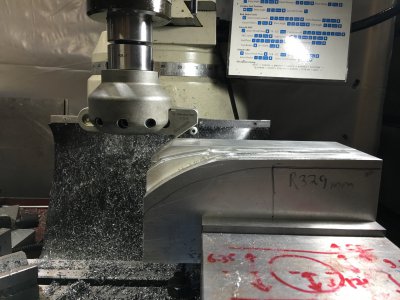- Joined
- Oct 3, 2013
- Messages
- 26
Last year I bought a 3-axis DRO to go with a new BP clone, and I was excited to find out about the smooth arc function, however I cannot get it to work. I assume there are parameters I do not understand, but I'm a smart guy and I am at a loss. For reference, it is a DRO Pros 3M, Z on the knee (I also have an independent quill scale).
For reference, I have the origin set to the rear left corner of the work. The flycutter has a 73mm cutter radius.
I want to cut a convex 329mm radius arc which is centered at X120mm/Z-329mm. I will be hand feeding in Y, and I felt that the flycutter would be a better option than an end mill, for the radius of the insert and for the fewer passes I'll have to take. I would also consider turning the work to cut Y/Z instead of X/Z, and then I'd be able to use the X-axis power feed. I think the programming would work the same either way.
The cut I want to make is similar to the sharpie mark on the front face of the work. Can anyone help me figure this out?

For reference, I have the origin set to the rear left corner of the work. The flycutter has a 73mm cutter radius.
I want to cut a convex 329mm radius arc which is centered at X120mm/Z-329mm. I will be hand feeding in Y, and I felt that the flycutter would be a better option than an end mill, for the radius of the insert and for the fewer passes I'll have to take. I would also consider turning the work to cut Y/Z instead of X/Z, and then I'd be able to use the X-axis power feed. I think the programming would work the same either way.
The cut I want to make is similar to the sharpie mark on the front face of the work. Can anyone help me figure this out?


